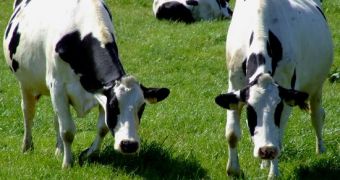A paper published in the journal Proceedings of the National Academy of Sciences this past December 16 documents the ecological footprint of various types of livestock.
According to this report, the cows that people raise for their meat or milk are top greenhouse gases emitters. Otherwise put, cattle farms harm the environment more than sheep, pigs and poultry farms do.
More precisely, the specialists who took part in this investigation say that, for the time being, cattle worldwide are to blame for over three-quarters (77%) of the global greenhouse gases emissions that are associated with livestock.
What's interesting is that cows, pigs, sheep, poultry and other animals that people consider a food source have a different ecological footprint depending on what breed they are, where they live and what they eat on a daily basis, EurekAlert says.
Specifically, emissions from livestock are said to be the highest in developing countries, which account for 75% of the global cattle- and other ruminants-related global emissions, and 56% of the global poultry- and pigs-related emissions.
Besides, various animals' impact on the environment depends on how efficiently they turn the resources that they consume into milk, meat or eggs.
Thus, the researchers found that animals raised in countries in the developing world require more food in order to produce one kilogram of protein.
This means that they go through more resources than animals living in developed countries within a given time frame, and therefore cause more damage to the environment.
The same source tells us that, as far as the researchers who carried out this study could tell, producing pork and poultry is more environmentally friendly than producing beef and milk.
More precisely, it appears that, on a global scale, pork and poultry produce some 24 kilos of carbon and 3.7 kilos of carbon, respectively, per kilo of edible protein.
By comparison, ruminants, i.e. cows, sheep and goats, were found to produce anywhere from 58 – 1,000 kilos of carbon per kilo of edible protein.
“The large differences in efficiencies in the production of different livestock foods warrant considerable attention. Knowing these differences can help us define sustainable and culturally appropriate levels of consumption of milk, meat and eggs,” the researchers write in their paper.
The report was pieced together by speacialists working with the International Livestock Research Institute (ILRI), the Commonwealth Scientific and Industrial Research Organisation (CSIRO) and the International Institute for Applied Systems Analysis (IIASA), and took about four years to complete.
The greenhouse gases emissions that the specialists focused on were the ones linked directly to the animals, i.e. compounds that hit the atmosphere as a result of digestion or through manure production.

 14 DAY TRIAL //
14 DAY TRIAL //